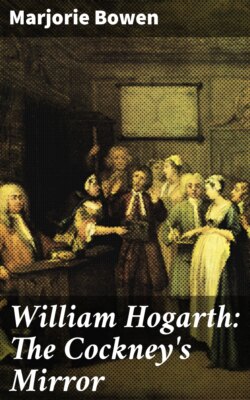Читать книгу William Hogarth: The Cockney's Mirror - Bowen Marjorie - Страница 15
На сайте Литреса книга снята с продажи.
* * *
ОглавлениеTable of Contents
A stranger, taking the 'ambulator' for his guide, would, first, have been told of the great size, wealth, and splendour of the City; it had two-thirds of the whole trade in England and one-seventh of the people, a Cathedral, two collegiate churches, seventy-four other churches, nearly as many meeting-houses for Dissenters, three choirs of music, three synagogues, seven Popish chapels, thirteen hospitals, four pest-houses, three colleges, one hundred and thirty-one charity schools, the finest of which in a circuit of ten miles was the Foundling Hospital in Lamb's Conduit Street, fifteen meat markets, two cattle markets, twenty-five other markets, fifteen Inns of Court, and twenty-seven prisons.
Besides these signs of wealth and splendour there were other evidences of prosperity, in the form of over twenty squares, three stately bridges, London, Westminster, and Blackfriars, a Guildhall, an Exchange, a customs-house, two Bishop's palaces (London and Ely), and three royal palaces, St. James's, Somerset House, and Whitehall, besides the noble ruins of the Savoy.
Among the conveniences of the capital were the one thousand hackney coaches plying for hire, the sedan-chairs, which were also easily obtained, and the number of expert watermen with their wherries ready to convey the citizen or the visitor up or down the river, which was the High Street of the capital.
The seven gates that still stood were demolished in 1760, with the exception of Newgate, and a handsome arch had, since 1670, marked the boundaries of the City by the buildings and gardens of the Temple.
There were three artillery grounds; the artillery itself was kept at the Tower, where were also the armoury, the regalia, the Mint, and, a cause of great pride to Londoners, the menagerie of strange beasts and birds.
Most of the notable buildings of the City were new at this date, the Mansion House, the General Post Office, the Mad House in Moorfields, new London Bridge with the handsome Gate House, the Bank of England; the Exchange dated from 1669 and Saint Paul's, 'the finest Protestant church in the world,' had not been long completed.
Other much admired buildings 'in the modest taste' were Doctors' Commons, Surgeons' Hall in the Old Bailey, and Physicians' College in Warwick Lane.
Southwark contained six parishes and was 'inferior to few cities in England;' much of its ground was, however, covered with warehouses and tenements; there were two famous hospitals, St. Thomas's, and that endowed by the bookseller Thomas Guy, who made a fortune out of Bibles and by speculating in South Sea stock.
Southwark felt great pride also in a new Magdalen House, and an obelisk in St. George's Fields, which was nobly surrounded with lamps.
Westminster boasted the Abbey, the School, the Hall 'without one pillar to support it'—and the new Buckingham House, as well as the two ancient palaces and St. James's Park. Somerset House, built by Inigo Jones, still stood, and was used for Government offices; the noble bridge was begun in 1738 and completed in 1750; it had several watch-houses, twelve watchmen, and thirty-two lamps, each with three burners.
Several fine churches were particularly pointed out to the attention of the stranger, St. Margaret's, St. Martin's-in-the-Fields, St. Paul's, Covent Garden, St. Mary's-le-Strand, Saint Giles's, St. George's, Hanover Square, but the greatest 'curiosity' was the British Museum, lodged in Montague House, Bloomsbury, which was to serve as a library for studious gentlemen and as a gallery for objets d'art and the Cotton and Harleian MSS., together with the Sloane collection and the libraries of the Kings of England from Henry VII.
There were, also, some antiquities and a set of paintings by Van Dyck; the public were admitted in batches on Tuesdays, Wednesdays, and Thursdays during the summer months, fifteen people at nine, fifteen more at eleven, and another fifteen at one o'clock.
